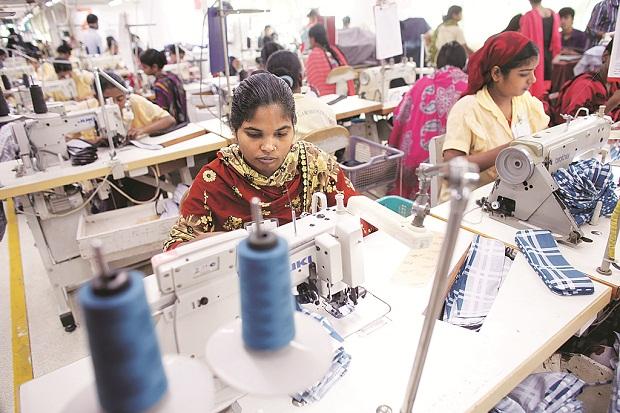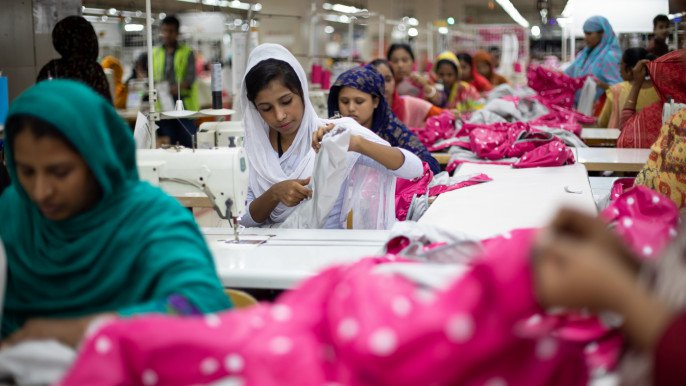Published in Business Standard on February 17, 2018

Automation is reaching into trades that once seemed immune, transforming sweatshops in places like Bangladesh and bringing production back to America
At the Mohammadi Fashion Sweaters Ltd. factory in Bangladesh’s capital, a few dozen workers stand watching as 173 German-made machines knit black sweaters for overseas buyers. Occasionally the workers step in to program designs or clean the machines, but otherwise there is little for humans to do.
It’s a big change from a few years ago, when hundreds of employees could be found standing over manual knitting stations for up to 10 hours a day. Mohammadi’s owners began phasing out such work in 2012, and by last year, the knitting process was fully automated.
“It doesn’t make sense for us to slow ourselves down” and not automate, says Rubana Huq, managing director of Mohammadi Group, which makes sweaters for H&M , Zara and other Western brands. Her factories have replaced about 500 workers with machines and may buy more, she says.
Even inexpensive workers in the world’s developing countries are vulnerable to automation, now that machines and robots are reaching into trades that previously seemed immune.
The apparel industry—unlike cars or electronics—seemed protected. Fabrics are notoriously difficult to work with, meaning nimble human hands are often better than machines. There was plenty of labor in Bangladesh, Cambodia and China, reducing the urgency to automate.
But labor costs have been climbing, even in developing countries. And technology is becoming so advanced that machines can increasingly handle difficult tasks such as manipulating pliable fabrics, stitching pockets and attaching belt loops to pants.
All that is upending the economics of the apparel industry, which long served as the first rung on the economic ladder for poorer countries, especially in Asia. A 2016 International Labor Organization study predicted some Asian nations could lose more than 80% of their garment, textile and apparel manufacturing jobs as automation spreads.
“I worry about developing countries—they are in the bull’s-eye of this automation revolution” as robots master repetitive tasks once dominated by poor nations, said Erik Brynjolfsson, director of the MIT Initiative on the Digital Economy. Most jobs of the future require significant skills training—and that is where more-developed nations thrive, he said.
Bangladesh offers a stark illustration of the problem. Analysts estimate it needs roughly two million new jobs a year to keep pace with its expanding labor force, with garments offering many of the best opportunities.
Yet the number of new jobs added by the garment and textile trades has fallen to 60,000 a year, from over 300,000 annually between 2003 and 2010, according to World Bank data. Government statistics show a crucial part of the supply chain—the production of basic textiles—is already seeing an outright decline in jobs.
Bangladesh’s apparel production, meanwhile, keeps surging, with help from automation, local business leaders say. From 2013 to mid-2016, annual Bangladeshi garment exports increased by 19.5%, according to figures from the leading garment industry body there.
Garment sector jobs increased by 4.5% over the same period, government statistics show.
“If you cannot absorb [young people] in productive activities, they will do something. And the something they will do may not be socially pleasant,” said Zahid Hussain, the World Bank’s lead Bangladesh economist. “It’s a social time bomb.”
There are plenty of upsides to automation in apparel, of course, especially in richer countries. By boosting efficiency, new technologies help keep consumer prices for jeans and other “fast fashion” products low. Automation could also help bring some apparel production back to places with more-expensive labor, including the US Softwear Automation, an Atlanta-based firm that develops automated tools for apparel factories, says that its “sewbots” will be used next year in a Little Rock, Ark., factory operated by Chinese garment producer Tinyuan Garments Co.
Adidas AG recently opened “Speedfactory” shoe production plants in Germany and the Atlanta area designed to use computerized knitting technology instead of armies of low-cost laborers.
In Bangladesh, Nazma Akter, a union leader, says savings from automation has emboldened factory owners to resist worker demands. In one recent labor dispute, she says, factory owners threw up their hands and said that if workers wouldn’t agree to management’s plans, they would simply automate jobs away.
“Factories that before had 300 workers now might have 100 workers only,” said Ms. Akter, who is president of the Sommilito Garments Sramik Federation.
The country’s biggest clothing producers say they have little choice but to automate as cost pressures intensify.
The collapse of the Rana Plaza garment-factory building in Dhaka in 2013, which killed more than 1,100 people, focused global attention on the need to make upgrades to factories around the world, especially in Bangladesh.
Consumers, accustomed to a widening array of inexpensive fashions, have resisted price increases that could help pay for them. The emergence of new competitors, including East African nations, has added further pressure.
“If you don’t change yourself, you will lose the entire business,” said Mostafiz Uddin, chief executive of Denim Expert Ltd., a Bangladeshi manufacturer that makes clothes for brands including Zara.
His multistory factory in the port city of Chittagong uses a Spanish laser-finishing machine, retailing for 150,000 euros, that burns fashionable holes into jeans with far greater precision than dozens of workers conducting the same task manually nearby.
Four other machines automatically sew stitching for jeans that have been damaged during the finishing process. Each one with a single operator can stitch as many garments as 12 workers on standard sewing machines, Mr Uddin says.
“The machine can do everything, you just program it,” says Mr Uddin, who says he’s become inured to complaints that automation leads to fewer jobs. “If we cannot sustain the business, where will the fair wages come from?”
The latest advances mark a major shift for the apparel trade. Although technologies introduced during the Industrial Revolution, like the sewing machine, helped mechanize some parts of the process, including fabric production, stitching and final assembly still typically involved large numbers of humans.
The shift from Europe and the US to Asia helped lift millions of people out of poverty in Taiwan and South Korea, and later in countries such as Thailand and China. When those places saw their own costs rise, apparel brands looked elsewhere.
Bangladesh, with 165 million people, leapt at the chance.
Derided as a “basket case” by then-US National Security Adviser Henry Kissinger after its 1971 independence from Pakistan, the flood-prone nation endured years of famine and military coups before garment-making took root.
From 2000 to 2010, Bangladeshi garment exports nearly tripled, helping to dramatically push down the number of people living in poverty, the World Bank says. Many were women from poor rural areas who migrated to the cities, including Dhaka, and sent earnings home. Today the industry provides three million manufacturing jobs and 81% of Bangladesh’s exports.
 CPD RMG Study Stitching a better future for Bangladesh
CPD RMG Study Stitching a better future for Bangladesh



